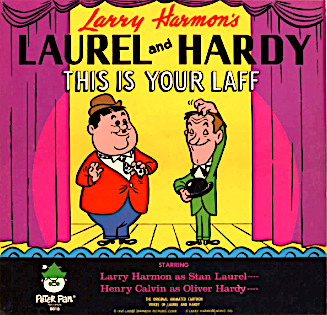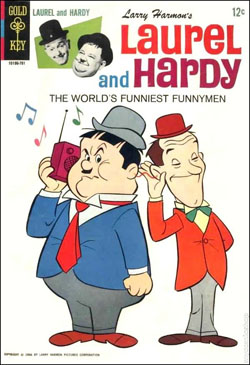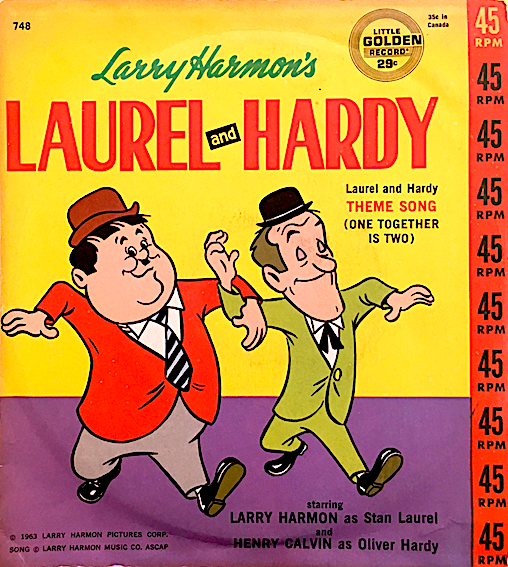Before Hanna-Barbera released its syndicated series based on the beloved duo, both Peter Pan and Golden produced two discs that could easily have been demos.

LAUREL AND HARDY IN “THIS IS YOUR LAFF”
Peter Pan Records # 8018 (12” 33 1/3 RPM / Mono / 1963)
LP Reissue: # 8181 (12” 33 1/3 RPM / Mono / 1976)
Executive Producer: Martin Kasen. Producer: Larry Harmon. Music: Jerry Livingston, Leonard Adelson. Don Ralke. Running Time: 37 minutes.
Voices: Larry Harmon (Stan Laurel, Officer, Boomer’s Assistant, Party Guest); Henry Calvin (Oliver Hardy); Paul Frees (Narrator, Construction Boss, Bank Robber, Officer, Police Captain, Mr. Boomer, Magnetic Spy, General, Big Red, Bartender, Chief of Police, Editor, Party Guest). (One additional uncredited actor provides female voices.)
Stories: “Chiller Diller Thriller,” “On-the-Move Movers,” “Flip-Top Tip-Top Secret Agents,” “Lucky Ducky Duckeroos,” “Whipper-Snapper Snoopers,” “Super Duper Sleuths.”
 This album takes the format of TV’s This is Your Life — which actually hosted the real-life Laurel and Hardy—and presents six comical adventures that took place in their fictional 1930’s past. One of the stories is a definite nod to the classic short, The Music Box, in which Stan and Ollie make match sticks from a piano as they try to move it up hundreds of steps. It’s not to be expected that the same level of comic genius could ever repeat itself here, but it’s a pleasant little tribute at the very least.
This album takes the format of TV’s This is Your Life — which actually hosted the real-life Laurel and Hardy—and presents six comical adventures that took place in their fictional 1930’s past. One of the stories is a definite nod to the classic short, The Music Box, in which Stan and Ollie make match sticks from a piano as they try to move it up hundreds of steps. It’s not to be expected that the same level of comic genius could ever repeat itself here, but it’s a pleasant little tribute at the very least.
 Like the Hanna-Barbera cartoons that appeared on TV three years after this album, there isn’t much about the stories that make them specifically “Laurel and Hardy-ish,” and keep them from being interchangeable with other cartoon characters. Like H-B’s sister series of 1966, the Abbott and Costello cartoons, they’re not much different from Lippy the Lion and Hardy Har Har episodes (albeit all arguably nice comfort TV for H-B aficionados).
Like the Hanna-Barbera cartoons that appeared on TV three years after this album, there isn’t much about the stories that make them specifically “Laurel and Hardy-ish,” and keep them from being interchangeable with other cartoon characters. Like H-B’s sister series of 1966, the Abbott and Costello cartoons, they’re not much different from Lippy the Lion and Hardy Har Har episodes (albeit all arguably nice comfort TV for H-B aficionados).
It’s an entertaining and well-produced recording, featuring exclusive music (some of which repeats a tad too often), sound effects and a good cast. It might have been nice if all of those involved were credited. Perhaps Bozo cartoon writer Charles Shows was the LP scribe. Paul Frees, of course, is unmistakable though uncredited.
The album does credit the wonderful Henry Calvin, who voiced Hardy on this LP and the 45 single. Calvin co-starred on Broadway in “Kismet,” and played Sgt. Garcia on Disney’s Zorro series. He also impersonated Oliver Hardy in a Dick Van Dyke Show episode called “The Sam Pomerantz Scandals” and played a Hardy-like character in Disney’s Babes in Toyland.
Hardy was recast on the 1966 cartoon with the also-wonderful Jim MacGeorge, who also played Stan Laurel on many occasions, including Anco windshield wiper commercials with the indeed-also-wonderful Chuck McCann as Ollie. With Harmon as Laurel, MacGeorge revived the voice for an episode of The New Scooby-Doo Movies in 1972 (which made sense since both cartoons were Hanna-Barbera productions).
Chiller Diller Thriller
This is the first selection on the album. It sets up the “This is Your Laff” format and Paul Frees does several voices. Peter Pan released this as a 7-inch 33 1/3 RPM record, one of a series of cartoon and superhero story records.

LAUREL AND HARDY THEME SONG
(ONE TOGETHER IS TWO)
Larry Harmon as Stan Laurel & Henry Calvin as Oliver Hardy
Little Golden Records FF-748 (7” 45 RPM / Mono / 1963)
Executive Producer: Arthur Shimkin. Producer: Larry Harmon. Music: Jerry Livingston, Leonard Adelson. Musical Direction: Don Ralke. Running Time: 3 minutes.
The original 1930 Laurel and Hardy theme, “Dance of the Cuckoos,” by Marvin Hatley was not Harmon’s property, so Hollywood songsmiths wrote another theme “sideways.” An example of this is how Cole Porter, when asked to come up with something like ”Make ‘Em Laugh,” wrote “Be a Clown.” The structure is similar, but it’s not the same piece of music, per se. And Heavens to Betsy—it stills happens today.
 Harmon did not own “Bozo’s Song.” It was written by Alan Livingston and Billy May and owned by Capitol Records. But the new Laurel and Hardy song “One Together is Two” gave Harmon publishing rights (and the fees to which Livingston and Adelson were entitled). The title credits on the 1966 Hanna-Barbera cartoons carefully listed the song publishing (and character merchandising) information.
Harmon did not own “Bozo’s Song.” It was written by Alan Livingston and Billy May and owned by Capitol Records. But the new Laurel and Hardy song “One Together is Two” gave Harmon publishing rights (and the fees to which Livingston and Adelson were entitled). The title credits on the 1966 Hanna-Barbera cartoons carefully listed the song publishing (and character merchandising) information.
The test of time has been proven “March of the Cuckoos” to outlast “One Together is Two.” The two pieces of music sound so much alike, there was ultimately never a need for the new one to replace the other as the original films have only gained in stature as revered classics.
Don Ralke is credited on this Little Golden Record, which makes it a safe assumption that he also handled the original score for the Peter Pan LP. It can only be guessed at this point as to why Golden released one record and Peter Pan did the other. The three years between these records and the Hanna-Barbera cartoon invite speculation about how these were both used as promotional devices, not just to sell the premise as a series to producers and programmers, but also to merchandisers.
Harmon had acquired the rights for the likenesses and names of Laurel and Hardy from the widows of each, then sought ways to expand their reach into animation, toys and popular culture beyond the original films (which he did not own). He had such success with taking Bozo from a recordings-only character to a TV and merchandise franchise, this was his next step, especially since the films of early comedy teams were gaining new young audiences—especially the Three Stooges, who already had a cartoon show and live-action movies.
The issues surrounding such an enterprise are prime fodder for a book in itself, but for the purpose of Spin—which tries to swim around in the nice, cozy cartoon-and-record pond—these are two very interesting and very “cartoony” records.
“One Together is Two”
Side one contains an instrumental, with some repartee between the two fellows and then the complete vocal. More than the LP, this short record sounds especially as if it was part of a sales presentation package to be given to prospective clients interested in licensing the characters.


 GREG EHRBAR is a freelance writer/producer for television, advertising, books, theme parks and stage. Greg has worked on content for such studios as Disney, Warner and Universal, with some of Hollywood’s biggest stars. His numerous books include Mouse Tracks: The Story of Walt Disney Records (with Tim Hollis). Visit
GREG EHRBAR is a freelance writer/producer for television, advertising, books, theme parks and stage. Greg has worked on content for such studios as Disney, Warner and Universal, with some of Hollywood’s biggest stars. His numerous books include Mouse Tracks: The Story of Walt Disney Records (with Tim Hollis). Visit 





















































The cartoon’s credit to L&H’s signature song confused me as a yute as to the actual title of the song used in the Hal Roach comedies — even though they were obviously two different songs — until PBS ran a (I believe BBC) documentary on Laurel & Hardy in the 1970s which provided the correct “March of the Coocoos” title.
(Also, as far as substitute Stan & Ollie pairings go, there’s a YouTube video from a 1958 episode of The Gary Moore show on CBS, with Dick Van Dyke as Laurel and Chuck McCann as Hardy.)
Good point, and I love your usage of “yute” (not a coined word, btw)!
“An example of this is how Cole Porter, when asked to come up with something like ‘Make ‘Em Laugh,’ wrote ‘Be a Clown.’ ”
No — “Be a Clown,” composed by Porter for 1948’s THE PIRATE, preceded the Brown & Freed “Make ‘Em Laugh.”
Nacio Herb Brown and Arthur Freed penned “Make ‘Em Laugh” specifically for 1952’s SINGIN’ IN THE RAIN — it was the first song the composer and producer-lyricist had written together for many years. [Most of the rest of the score of SINGIN’ is comprised of songs Brown and Freed had written in the ’20s and ’30s.] It is very close in tone, mood and spirit to “Be a Clown.” [When Irving Berlin heard the song, he was shocked; he told Freed, “Arthur, that’s ‘Be a Clown’!” The song became a standard regardless…
I’m grateful for the accuracy and the great story! See, I thought “Moses” was the only original song in Singin’ in the Rain, but I guess it was Green and Comden’s only original song. Thanks again!
omg. I HAD this album. I hated it, actually.; I was so bummed (even in 1960!)….that it was just….”not THEM!” The cartoons? Burn ’em with 60s popeyes!!
“The Laurel & Hardy Scrapbook” by Jack Scagnetti, 1976, includes a brief account of Harmon’s legal battle with Roach. The book quotes Harmon as having huge plans, including an animated theatrical feature (slated for ’76), a theme park, and a chain of pie shops (pizza, not custard). There’s a menu for the pie shop, so maybe at least one actually opened. I would dearly love to see concept art for a Laurel and Hardyland.
The only time I saw an L&H cartoon on TV was when I stumbled across a local Bozo show in the early 70s. Evidently they were part of the franchise package, like the cartoons of Bozo himself. Were they shown outside of the Bozo shows?
To this day I see vintage stuff using the HB character designs. An academic question would be to what extent the merchandise sold on the recognition of the cartoons compared to the recognition of the original films (see “Uncle” Wayne, above). L&H shorts (and “fake shorts” consisting of feature excerpts) still turned up on local TV at least to 1970; the Robert Youngson compilations got fairly heavy play; and “March of the Wooden Soldiers” was a holiday constant.
The Laurel & Hardy cartoons were shown locally in Seattle where I grew up. In the late 60’s they were aired as part of “The J.P. Patches Show”–a local clown, much beloved by legions of Seattle children who grew up as “Patches Pals.” His show always included cartoons–it’s how I got my exposure to the theatrical shorts from WB, MGM, Van Buren, and so forth as well as the 60’s “Popeye” cartoons, the “Beetle Bailey and “Snuffy Smith” cartoons, the Terrytoons, the Mel-o-toons, etc. For at least a couple of years the L & H cartoons were added into the mix. J.P. Patches had a ninety-minute show in the mornings (which pre-empted half an hour of “Captain Kangaroo” but the local kid viewers didn’t raise any objections, because the local show was a better show overall), then a half-hour show in the afternoons, and an hour show on Saturday mornings, which I believe regularly beat out the ratings on the regular Saturday cartoons.
Needless to say, a kid growing up in Seattle in the 60’s got a great education in theatrical and TV cartoons. The programmers often changed it up as to what cartoons were available to be run on the show, and this kept the show fresh. The Laurel and Hardy cartoons were a welcome part of the package.
I’m guessing other local stations similarly ran the L & H shorts as part of their kids’ programming.
Here in Los Angeles,. those and the Abbott and Costellos were also a large part of MY diet, too, FW!
A number of the lost episode of Laurel and Hardy Cartoons can be found on DVD here
https://www.matsune.com/wbc/worldsbestweb/cartoonvidlist_l.htm
in visiting the L&H Museum (in Georgia), the place is chock-o-BLOCK with Harmonizings.